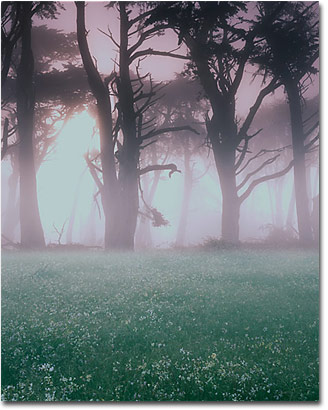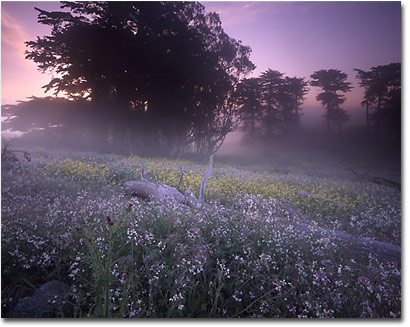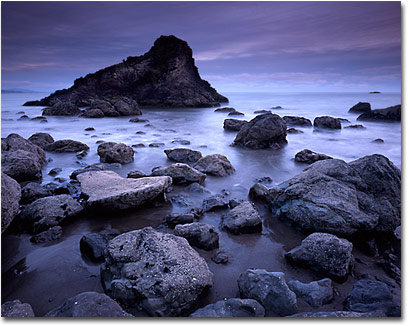|
|
 Switching to Large Format Photography and Text Copyright Dan Baumbach A couple of months ago, at an art gallery, I had the good fortune to see large prints by some of my favorite nature photographers. I wandered around the gallery looking at works by William Neill, Joseph Holmes and others, and a 40x50 print of Charles Cramer brought tears to my eyes. This gallery was only about half an hour from Yosemite National Park. Did I walk out of the gallery excited and rush to the gates of the park to make my own masterpieces? No, I walked out of the gallery horrified.
Yes, I too wanted to take photos and make prints like this. There was only one problem. I was shooting 35mm. All of these photos were shot with
I not a stranger to large format, having taken 4x5 Ektachromes of my fatherís paintings 30 years ago. But 4x5 landscape photography? Thatís for those slow working contemplative types, you know, people who can stare at a ground glass for hours just to compose the perfect shot - then wait for hours more for the perfect light. Iím a high-strung 35mm type, if the wind doesnít die down in a minute or two, Iím on to the next shot. There was always medium format. 645 (1 5/8Ē x2 ľĒ) is hardly 2 times larger than 35mm. Why bother. Thereís always 6x7 (2 ľĒx2 ĺĒ) but these cameras provide no movements, and depth of field can be a problem with their longer lenses. I explained my dilemma to my wife and knew I married the right woman when she suggested I take some of our very limited funds and purchase a 4x5 camera and give it a try. I still resisted. I couldnít imagine myself working in 4x5, but I finally gave in. I decided to get an inexpensive camera with a couple of lenses and if it didnít work out I would sell them all on eBay. Where should I start? This was not just a choice between Canon and Nikon. It was a choice between Linhof, Arca Swiss, Wista, Wisner, Zone IV, Shen-Hao, Toho, Canham, Ebony and more. And what lenses should I get? Thereís Schneider, Nikkor, Rodenstock, Fujinon, Caltar and others. At least all lenses would fit any camera; you just have to mount the lens in the appropriate board (for that camera). In desperation I sent off an email full of questions to NPN moderator Guy Tal. Guy has been posting beautiful 4x5 images in the Earth, Sea and Sky forum for a while now. Guy recommended some links (at the end of this article) where I could find more about different 4x5 cameras and lenses. He suggested the Shen-Hao camera and told me late model lenses by well-known manufacturers are very good. Guy also gave me links for good places to purchase the equipment. Between Guyís suggestions and reading up on the Web, I decided to purchase a Shen-Hao field for $625 (about half the price of other wooden field cameras) from Badger Graphics. They didnít have the lenses I wanted but with luck I was able to find them used at Midwest Photo Exchange and saved about $500. I bought 75mm and 150mm lenses, which are equivalent to 22.5mm and 45mm lenses for 35mm cameras. These corresponded closely to the focal lengths that I used a lot for my 35mm work. My plan was that as I got more comfortable working in 4x5 I would buy more focal lengths as needed.
One other thing I did was look at my best photos that Iíd shot with 35mm and try to imagine how I would shoot them with my new camera. This was and is very helpful to me in devising strategies for shooting with my new equipment. The day came when I finally got my camera and lenses, mounted the lenses in the lens boards and set up for a sunrise shoot the next day. I knew the shot was a bit ambitious and probably required a focal length that was in between my 75 and 150, but I had my new camera and I was jazzed. The next morning I got at 4:30 a.m. to make the hourís drive to Point Reyes National Seashore. About 15 minutes into the trip I realized that I forgot my watch, but I didnít think Iíd need it. Once I arrived in the early morning light and was setting up my camera, I found that I didnít tighten the lens in the lens board enough; so when I mounted a graduated filter in it, it just rotated so that the filter was upside down. Then I realized that Iíd need my watch for exposures. I didnít have a camera with me with shutter speeds to 30. The leaf shutter on my lenses went down to only 1 second, for exposures slower than that, Iíd have to time with a watch. Still I tried to make a shot. I opened up the shutter, put the focusing cloth over me and looked at the ground glass. I could make out the center pretty well, but seeing the edges of the ground glass even with a loupe was very difficult. How the heck was I going to compose a photo if I couldnít see the edges of the frame? I was beginning to think Iíd made a big mistake. Discouraged and frustrated I decided to go home. Later that day I read everything I could find about seeing the image on the ground glass of a view camera. Apparently seeing the edges of the frame with wide-angle lenses is difficult even for experienced photographers. What would help is a focusing screen with a fresnel lens. Fresnel lenses are a standard part of the focusing screen on all modern SLRs, but apparently not many view cameras come with them - beats the heck out of me why. I ordered a Beattie Intenscreen from Badger Graphics. Another choice was a Boss screen from Bromwell Marketing. I had already ordered the Beattie screen when I came upon information about the Boss screen and although it seems to have a better rating, Iíll stick with what I have for a while. Iím now able to see the frame with the Beattie screen. It is, however, not as easy to focus as with the plain ground glass.
When I shot 35mm, Iíd look at a scene that I wanted to photograph, figure what zoom lens I needed and look at the scene through my camera and lens while zooming in and out to create the best composition. No such luck with large format. There are no zooms for large format. I also only had two lenses so I was much more limited than the average 4x5 photographer. What I found myself doing was looking for the shot and the framing with just my eyes and maybe my hands. I would walk back and forth and look at the scene carefully until I came to the place where I thought I should place my camera for the shot that I wanted. Is this what it means to be more contemplative? A number of people recommended that I carry a stiff card with a cut out with the proportions of a 4x5 transparency in it and move that forward and back in front of my eyes to decide how to frame my shot. That is an excellent idea, but knowing myself, I knew that just as I got used to it I would somehow forget my card. So Iím still just using my eyes and hands. Itís surprising that composing with an image on the ground glass that is both upside down and backwards hasnít bothered me. I actually like it. I find it easier to judge composition that way. There are a number of monocular and binocular viewers made where you can see the image right side up but reversed left to right. The prices start at $350 and go up. At this point Iíll stick with what I have. My initial setup including film and a dark cloth was under $2100. I already had a good spot meter - one of those will set you back a few hundred. One thing Iíve been noticing is how much information a 4x5 transparency has. It adds a whole other dimension to the finished photograph-detail. Normally Iím looking at shapes and composition, but now detail is an integral part of my photography. Iíve been shooting 4x5 for about a month now and I am amazed how fast Iíve been able to adapt to working with it. I still make lots of mistakes and waste film, especially on sunrise shoots where Iím sleepy, but Iíve also been lucky enough to take some images that I feel are as good as anything Iíve taken on 35mm. It has slowed me some, but my way of working hasnít really changed that much. I love shooting with my new camera and making prints where I canít see any grain and where the detail goes on forever. Is large format for you? Only you can determine that. Guy recommended that I rent a camera and try it out before buying. This is excellent advice, but I didnít take it because I already knew that I didnít want to shoot 35mm anymore, so I took the plunge. All I can say is that the choice is a lot bigger than between Canon and Nikon. Large Format Links Informational Resources
Editor's Note - Be sure to visit dan's web site at www.timelesslight.com to view more of his work. Dan Baumbach - NPN 114 Comments on NPN landscape photography articles? Send them to the editor. |
|
|
 large format 4x5 cameras. Even in 40x50 prints, the detail that was revealed was amazing. To enlarge a 4x5 transparency to 40x50 you only had to enlarge it 10 times, the equivalent of an 11x14 print from 35mm. By the time you enlarge a 35mm image to 40x50 (even a digital one), the resolving power of the lens, let alone the film or digital sensor, could not provide detail and sharpness like this.
large format 4x5 cameras. Even in 40x50 prints, the detail that was revealed was amazing. To enlarge a 4x5 transparency to 40x50 you only had to enlarge it 10 times, the equivalent of an 11x14 print from 35mm. By the time you enlarge a 35mm image to 40x50 (even a digital one), the resolving power of the lens, let alone the film or digital sensor, could not provide detail and sharpness like this. While waiting for my equipment to arrive, I read up as much as I could on how to operate a 4x5 camera. I had a very good book called Using the View Camera by Steve Simmons (Amphoto Press) that I highly recommend. From this book I was able to understand the basic functioning of the 4x5 camera and Steve gave numerous illustrated examples of different photos and how they were captured. I also got a copy of View Camera Magazine, which added to my increasing knowledge.
While waiting for my equipment to arrive, I read up as much as I could on how to operate a 4x5 camera. I had a very good book called Using the View Camera by Steve Simmons (Amphoto Press) that I highly recommend. From this book I was able to understand the basic functioning of the 4x5 camera and Steve gave numerous illustrated examples of different photos and how they were captured. I also got a copy of View Camera Magazine, which added to my increasing knowledge. Now that I could actually see what I was shooting, I went out to shoot again, once more excited about producing images with my new camera. I went to one of my favorite locations, Muir Beach, because I wanted to concentrate on learning the camera and not learning a new location. I put together a shot and determined exposure by spot metering on sand in the foreground and underexposing 1 stop as I thought the sand was pretty dark. I had no built in Matrix metering to check my exposure against so I was spot metering without a net. When I got the chromes back they were well exposed and in focus. It wasnít the best composition or most compelling sunset, but I had succeeded in taking a photo and I was thrilled!
Now that I could actually see what I was shooting, I went out to shoot again, once more excited about producing images with my new camera. I went to one of my favorite locations, Muir Beach, because I wanted to concentrate on learning the camera and not learning a new location. I put together a shot and determined exposure by spot metering on sand in the foreground and underexposing 1 stop as I thought the sand was pretty dark. I had no built in Matrix metering to check my exposure against so I was spot metering without a net. When I got the chromes back they were well exposed and in focus. It wasnít the best composition or most compelling sunset, but I had succeeded in taking a photo and I was thrilled!